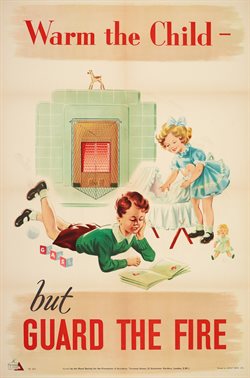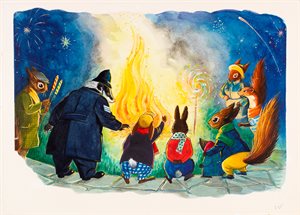 Throughout the past two centuries, Britons have experienced personal and collective tragedies involving burns and scalds, which have been connected to British culture and society and rooted in the habits and design of home, workplace, war and play. This project investigates how burns have shaped identity: individual and collective. In 19th-century Britain, the mortality rate for burns injuries was 50%. Between 1900 and 1950, of the 100,000 people burnt and scalded every year, 20-30,000 were admitted to hospital and around 2,000 died - over half of them children. Today, burns injuries make up 175,000 of all A&E visits; 16,000 people are hospitalised and 300 (2%) die.
Throughout the past two centuries, Britons have experienced personal and collective tragedies involving burns and scalds, which have been connected to British culture and society and rooted in the habits and design of home, workplace, war and play. This project investigates how burns have shaped identity: individual and collective. In 19th-century Britain, the mortality rate for burns injuries was 50%. Between 1900 and 1950, of the 100,000 people burnt and scalded every year, 20-30,000 were admitted to hospital and around 2,000 died - over half of them children. Today, burns injuries make up 175,000 of all A&E visits; 16,000 people are hospitalised and 300 (2%) die.
On the surface, this is a story of progress, yet in some ways this is just skin deep. Unlike other aspects of public health, there has been little progress in burns prevention. According to burns pioneer Dr Leonard Colebrook in 1950, statistics, such as those above, reflected peculiarly-British practices: tea drinking, open fires in homes, and widespread use of inflammable, raised-nap cottons. Not only is meaning attributed to the causes, but the material culture of burns – from changing fuels to the resultant technologies that shape how we live – is also tied into what being modern meant at key moments in the wider chronology of British history. For emergency services, emerging hazards meant pooling information and devising countermeasures, informing the design and construction of new, safer homes and workplaces. This project examines how these decisions were reached.

While burns incidents have influenced the professionalisation of ambulance and fire services, little is known about the roles played by emergency services in co-ordinating life-saving and treatment. Moreover, given that many ambulance services evolved out of municipal fire brigades in the early 20th century (including our three cities), both services are ripe for comparative study to better understand their joint roles as first responders to emergencies. Alongside this, priorities around treatment have shifted from resuscitation and isolation in the 1840s (when the first 'burns unit' was established in Edinburgh in 1845), to infection control and shock prevention in the 1890s, and reconstruction in the 1940s. Each shift has introduced new specialists to burns teams. Gradually, as mortality rates began to fall noticeably after the Second World War, the ultimate goal of burns practitioners also changed from survival to full rehabilitation and psychological recovery.
Despite this progress, burns remain a visually distinct, sensually assaulting and emotionally overwhelming injury, with significant effects on mobility, the self and identity. They also have a significant bearing on psychological wellbeing, not only of the injured, but their families and those involved in fire rescue and burns treatment. Burns are felt to be horrific and iconic. Self-immolation in particular jars our collective and emotional response, but might also inspire people. In 2010, Mohamed Bouazizi set himself on fire in protest at police treatment in Tunisia. In doing so, he has been said to be the human spark for the Arab Spring and its darker wake. Indeed, rarely are burns just individual tragedies. They can galvanise collective action, as they did following the 1981 New Cross fire, which claimed 14 young lives and is recognised as having helped foster a Black British identity. The 1987 King's Cross fire was the largest fatal fire on the London Underground, killing 31 people and injuring 100 more. It transformed health and safety regulations in London's transport network and led to the creation of the Healing Foundation (1999), a charity working for people who have sustained burns injuries. The recent establishment of support groups suggests a more collective and consoling experience of burns, yet our cultural image of the person who experiences extensive burns remains that of a solitary, tragic, and mysterious figure – Miss Haversham and spontaneous human combustion.